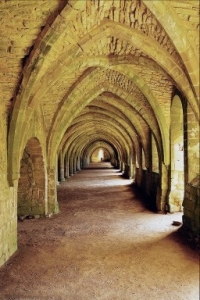| Mentor of
western monasticism and author of The Rule of Saint Benedict. |
 |
|
Cloister
from Foundations Abbey, England, founded
by Benedictines
|
Following an education
in Rome, Benedict withdrew from
contemporary life to pursue prayer and contemplation. Eventually he gathered
other hermits to his company and in time established several monasteries,
each presided over by an abbot. Later he moved his own community to Monte
Cassino. Benedict did not found an order. His lasting fame depends
rather on the so-called Rule of St. Benedict which he drew up for the
reform and ordering of monasticism. This rule provided for a demanding
but moderate asceticism. Benedict required that monks establish permanent
residence in a community, offering unconditional obedience to the Rule
and to abbots chosen to rule over monasteries for life. The daily life
of these monasteries, as Benedict envisioned it, was to be devoted to
prayer and physical labor. Benedict himself says little about study, but
this also became a prominent part of Benedictine life. With the approval
of the pope, Benedict's Rule and Benedictine monasticism became the prevalent
form of monasticism in the West.
|